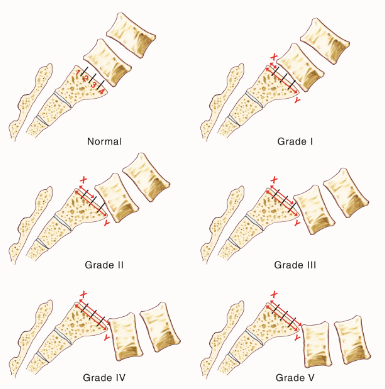Spondylolisthesis occurs when one vertebra slips forward on the adjacent vertebrae. The word comes from the Greek – spondylos, meaning “vertebra” and olisthesis, meaning “dislocation.” With this condition, one of the vertebrae in the spinal column moves out of place (forward, backward, or sideways) in relation to the vertebra below. This is one type of true spinal instability and can result in both back pain and neurologic problems. There are several different types of spondylolisthesis.
Displacement of the vertebra can narrow the space in the spinal canal, as well as put pressure on adjacent nerves resulting in neurologic symptoms. Although spondylolisthesis can occur anywhere in the spine, the lower back (lumbar spine) is the most common area affected.
The 3 most common types of spondylolisthesis are listed below:
Types of Spondylolisthesis
Isthmic spondylolisthesis
This type of spondylolisthesis is caused by a fracture of the pars interarticularis or isthmus, the bony bridge that connects the facet joints. It is often associated with sports that involve repetitive stress to the lumbar vertebrae and/or entail hyperextension of the spine. If a defect in the pars interarticularis can be identified, but no slippage has occurred, the condition is termed spondylolysis. If separation or displacement of this fracture occurs, the vertebra will disconnect from the facet joints that normally function to restrain the spine and maintain normal spinal alignment. The resulting slippage of the vertebrae is termed a spondylolisthesis.
Degenerative spondylolisthesis
This type of spondylolisthesis is most often seen in older patients. In degenerative spondylolisthesis there is no pars defect, and the vertebral slippage is never greater than 30%. This type is caused by arthritis of the paired facet joints in the back of the spine along with degeneration of the intervertebral disc. Arthritis of the joints can cause the joints to be painful and fit loosely. This may lead to instability of the spine with slippage of the vertebrae and further wear and tear on the intervertebral disc.
Congenital spondylolisthesis
Present from birth and caused by abnormal bone formation in the spine. Spinal misalignment puts the vertebrae at greater risk of slipping out of place.
Other, less common types of spondylolisthesis include:
Pathological spondylolisthesis
Brought on by disease (e.g., osteoporosis), infection, or abnormal growths (e.g., tumors) that cause bone weakness.
Post-surgical spondylolisthesis
Vertebrae can become displaced as a result of surgery.
Traumatic spondylolisthesis
Direct injury to the spine can cause spinal fractures or displacement of vertebrae.
Symptoms
Most individuals with spondylolisthesis experience pain when standing, walking, or bending backward. Symptoms include:
- Severe or “burning” back pain
- Pain worse after exercise
- Sciatica, leg pain, weakness, and/or numbness
- Spondylolisthesis may also be associated with spinal stenosis and neurogenic claudication—cramping pain in the buttock and thighs associated with premature fatigue and tiredness when walking distances.
Treatment
Early detection and diagnosis are important. Treatment with Dr. Stieber is directed toward restoring spinal stability and preventing ongoing damage to the nerves.
The degree of vertebral slippage is obtained from spinal X-rays and graded as follows:
Grade I: 1-25%
Grade II: 26-50%
Grade III: 51-75%
Grade IV: 76%-99% slip.
Grade V: Complete slip (100%), known as spondyloptosis.
Dr. Stieber considers the degree of displacement and other factors, such as intractable pain and neurological symptoms when determining treatment. Many cases of spondylolisthesis are Grade I or II. As a general rule, more severe slips (Grades III and higher) require surgical intervention.
Some cases of spondylolisthesis can be treated with short-term bed rest, activity restriction, medication, and other non-operative options. If your condition does not improve with conservative treatment, Dr. Stieber can suggest surgical solutions to relieve pain and increase the level of function. Spinal fusion is generally necessary to halt slip progression and stabilize the spine. Dr. Stieber employs the most current minimally-invasive techniques when spinal stabilization is required allowing shorter hospital stays, decreased pain, more rapid recovery, and a return to an active lifestyle.

